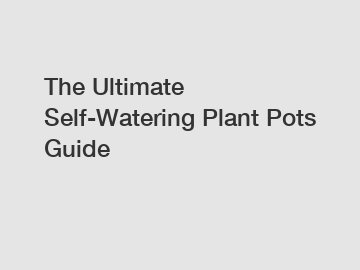Feb. 03, 2024
Home & Garden
Welcome to the ultimate self-watering plant pots guide! When it comes to maintaining healthy and thriving plants, we know just how important it is to find the right balance between water supply and drainage. Self-watering plant pots provide an ingenious solution by eliminating the guesswork and ensuring your beloved greenery receives just the right amount of hydration. In this comprehensive guide, we will explore the benefits, types, and tips for choosing and using self-watering plant pots, so your plants can flourish effortlessly.
Section 1: The Benefits of Self-Watering Plant Pots.
Self-watering plant pots have gained popularity for a good reason. They offer numerous advantages over traditional pots, making them a top choice for both experienced gardeners and beginners alike. Here's a closer look at some key benefits:

1. Water Conservation: Self-watering plant pots prevent water wastage by delivering moisture directly to the roots, reducing the need for frequent watering.
2. Consistent Hydration: These pots create a self-sustaining watering system that ensures your plants receive a consistent supply of water, reducing the risk of over or under watering.
3. Enhanced Plant Health: By maintaining optimal moisture levels, self-watering pots promote healthier and more robust root growth, resulting in stronger and more vibrant plants.
4. Time-Saving: With self-watering pots, you can spend less time worrying about watering schedules and focus on enjoying your green oasis.
Section 2: Types of Self-Watering Plant Pots.
Self-watering plant pots come in various designs and sizes to suit different plant needs and personal preferences. Here are some popular types:
1. Reservoir Systems: These pots feature a reservoir at the bottom, which holds the water that plants absorb gradually through capillary action.
2. Wick Systems: Utilizing a wick mechanism, these pots draw water from a separate reservoir while reaching the plant's roots, maintaining the perfect moisture balance.
3. Hydroponic Self-Watering Planters: Ideal for indoor gardening, these pots use a water-based system with added nutrients, ensuring an optimal growing environment for your plants.
4. Hanging Basket Self-Watering Pots: Perfect for vertical gardening, these pots incorporate water reservoirs, ensuring a steady flow of moisture to your hanging plants.
Section 3: Choosing the Right Self-Watering Plant Pot.
Selecting the suitable self-watering plant pot is crucial to ensure your plants receive the care they need. Here are some factors to consider:
1. Plant’s Water Needs: Different plants have varying moisture requirements. Consider the species you wish to grow and find a pot that can deliver the appropriate amount of water.
2. Size and Space: Ensure the pot provides enough room for your plant's root system to grow healthily and comfortably fit the space you have available.
3. Material: Self-watering plant pots are available in a range of materials, such as plastic, ceramic, or terracotta. Consider the aesthetic appeal, durability, and insulation properties of each material.
4. Ease of Maintenance: Look for pots with clear water level indicators, easy access to the reservoir, and removable parts for convenient cleaning and refilling.
Section 4: Tips for Using Self-Watering Plant Pots.
Now that you have selected the perfect self-watering pot for your plants, here are some essential tips to ensure optimal usage:
1. Monitor Water Levels: Regularly check the water reservoir's level to ensure your plants receive a steady supply. Adjust the frequency of refilling based on your plant's needs and moisture requirements.
2. Proper Drainage: While self-watering pots maintain hydration, it's crucial to ensure excess water can still drain away to avoid root rot. Use appropriate soil mixes and follow recommended planting techniques.
3. Refilling with Nutrients: Over time, the nutrient content in self-watering pots may deplete. Occasionally top up the water reservoir with appropriate liquid fertilizers to maintain plant health.
4. Seasonal Adjustments: Consider seasonal variations in both indoor and outdoor environments. Monitor your plants' growth and adjust watering frequencies accordingly.
Conclusion:
Self-watering plant pots are a revolutionary invention for plant enthusiasts, offering a simple yet effective way to nourish and nurture your green companions. With their water conservation properties, simplified watering schedules, and overall ease of use, these plant pots are a must-have for any gardening enthusiast. By choosing the right pot, considering your plant's needs, and implementing proper usage techniques, you can take your gardening experience to new heights, resulting in healthier, lusher, and more vibrant plants. Happy gardening!
If you are looking for more details, kindly visit hanging wall planter wholesale supplier, plastic plant trays wholesale, Detachable Trash Can Custom.
If you are interested in sending in a Guest Blogger Submission,welcome to write for us!
All Comments ( 0 )